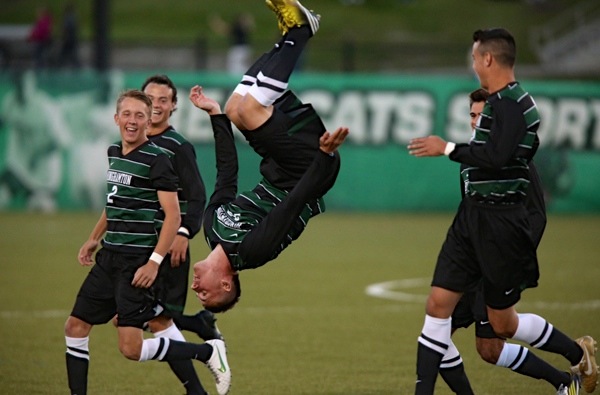By Ben Nicholson
November 6 – Following the tragic death of Peter Biaksangzuala, who suffered spinal injuries that proved to be fatal after celebrating a goal by attempting a back somersault, FIFA has moved to rid the game of somersaulting celebrations altogether.
Biaksangzuala was a 23 year-old player for Indian Mizoram Premier League team Vengthlang FC. His ill-fated somersault attempt was hastily performed after his scoring a goal, culminating in an awkward landing that left him unconscious.
Upon being taken to a hospital, a CT scan revealed he had suffered spinal damage. He was subsequently moved to an Intensive Care Unit where, due to medical complications, he passed away.
In reaction to the tragic event, FIFA – specifically FIFA’s Medical Committee Chairman Dr. Michel D’Hooge – has proposed plans to illegalize any such celebration attempts in the future.
D’Hooge has suggested that FIFA send out a directive to all players to refrain from somersaulting celebrations. Fearing that such instruction will be ineffective, D’Hooge’s grander plan is to pass a ruling that illegalizes these celebrations altogether.
“Fifa is warning all players not to put themselves in danger like this but I don’t think this will be enough to stop them”, D’Hooge stated. “I believe that it can only be imposed by new legislation making them illegal but this is going to take a bit more time. We have to go through a formal process and take in the views of other parties such as the players, referees and national associations.”
The issue looks set to be raised at the next International Football Association Board meeting on November 25 – where the agenda is set for the Spring AGM when rule-changing decision are taken.
FIFA would not have to take many broad steps to achieve their desire, since the wording of the relevant rule for “Fouls and Misconduct” in the “Laws of the Games”, under Law 12 – “Celebration of a goal”, reads as follows:
“While it is permissible for a player to demonstrate his joy when a goal has been scored, the celebration must not be excessive.
Reasonable celebrations are allowed, but the practice of choreographed celebrations is not to be encouraged when it results in excessive time-wasting and referees are instructed to intervene in such cases.”
Although FIFA has no precedent for labeling somersaults as excessive celebration, to hereon determine that the elaborate acrobatics are excessive is easily enough done. It could be achieved without even changing the wording of the rule.
As for the substantive argument for labeling somersault excessive, one need only look at the context of the act. Somersaulting heralds from other sports, generally speaking, and its performance could be likened to what you would expect to see at Cirque du Soleil, as opposed to a football match.
On the face of things, somersaults seem unrelated to a game of football. Their place in the game could well be determined an unnecessary danger. If somersaulting really is as dangerous as D’Hooge conceives, the burden of justification lies upon the would-be celebrators.
One such argument could take the form of pointing to the entertainment nature of football, which lends itself to the spectacular. The thousands of fans in the stadiums and thousands more watching at home seek excitement. Celebrating with somersaults not only heightens the spectacle of the sport but exacerbates the excitement of scoring, serving aims of producing joy in the game.
Whether this particular aspect of entertainment has a place in football is to be debated, but the regular applaud, and regular replaying of these celebrations in highlight reels, evidences enthusiasm for it.
D’Hooge’s expressed reasoning for the necessary outlawing of the celebration is for the safety of children. He fears that in seeing the somersaults, kids will unsuccessfully try to emulate their idols.
Of all the arguments potentially raised against somersaults for celebrations, this appears a weak one.
Firstly, if children were so susceptible to what they see, then the broadcast of gymnastics should be outlawed altogether. There is no evidence proffered that children suffer injuries from replicating a football player’s goal celebrations so regularly as to necessitate the imposition of a ban.
Secondly, the instance that has promulgated this discussion is unrelated to the issue of children copying what they see. A better directed policy would be to outlaw persons without competence from attempting acrobatics that they are not competent to perform.
Thirdly, if the ban were to pass under D’Hooge’s reasoning, it would have an encroaching effect on the playing of football itself. If somersaults are deemed overly dangerous to display to children, then what of bicycle kicks? Those, surely, are more dangerous since the correct performance of such acrobatics necessarily results in an inherently dangerous landing – be it on back, side, or front if one is so agile. On D’Hooge’s theory then an equal rule ought to be implemented to discourage children from similarly dangerous feat.
The dangerous nature of somersaulting celebrations is one that has received some limelight in previous years. Alex Ferguson reportedly instructed Nani to cease his acrobatic celebrations, in fear he may injure himself. (Nani subverted the issue, though, finding a unique solution to the problem by ceasing to score altogether.)
Another player who could well benefit from such a ruling would surely be Robbie Keane, whose amateur acrobatics (or perhaps aerobics is a better description) has for years distressed his ageing joints. Perhaps for the preservation of Keane alone, and for the preservation of aesthetic acrobatics all round, this rule ought to find traction.
Contact the writer of this story at moc.l1745071062labto1745071062ofdlr1745071062owedi1745071062sni@n1745071062osloh1745071062cin.n1745071062eb1745071062

